- Updated
- Sport
- Tokyo Olympics
This was published 3 years ago
The Defiant Games: The Tokyo Olympics begins at last
By Eryk Bagshaw
Tokyo: It took $37 billion, a bulldozing Olympic committee and a Japanese government resisting the will of its people, but on Friday the Tokyo Olympic stadium lit up in fireworks at last.
These defiant Summer Games weathered a year-long delay and a coronavirus pandemic that has killed 4.1 million around the world to bring 11,090 athletes to the Japanese capital.
The Olympic Stadium, capacity 68,000, was occupied by only 900 officials and dignitaries, the remaining seats rendered soulless by an indefatigable invisible enemy.
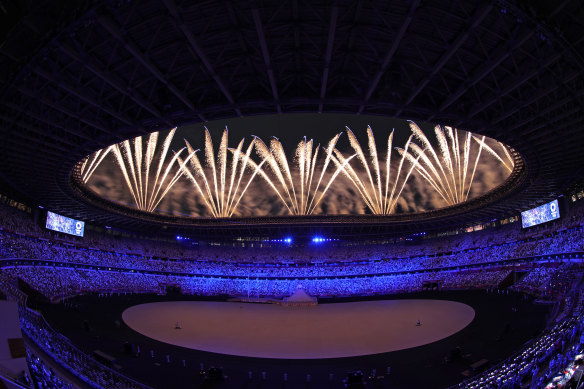
Fireworks light up the stadium at the start of the opening ceremony of the Tokyo Games.Credit: Getty Images
The opening ceremony started with a video showing the pure elation of Tokyo’s winning bid in 2013 and the momentum of the Games through until 2019 and the crushing blow of the pandemic, with the countdown finally culminating in the present day and fireworks – 694 of them – lighting up the sky.
This was a graphic-rich visual designed to illustrate Japan’s 20th century technical glory, with focus switching whimsically across to a lone female athlete on a treadmill. According to the organisers, the goal was to demonstrate that “all over the world, there are many other solitary athletes like her. They are all individual, separate ‘points’, but they are connected by an invisible bond.”
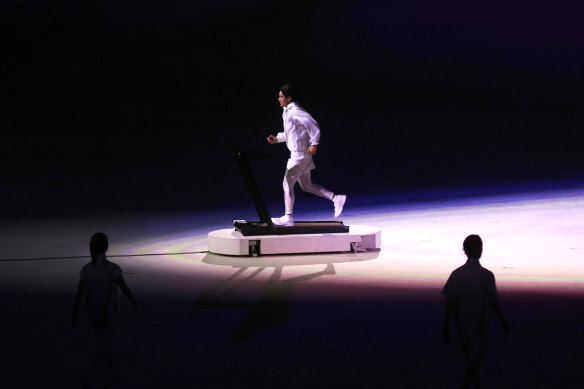
The protagonist of the ceremony, the lone athlete. Credit: Getty Images
But it felt empty, almost mournful as the Japanese flag was raised above the stadium – it will vie for the world’s attention for almost three weeks.
Just before midnight, Tokyo time, Naomi Osaka, the tennis star and Japanese icon, carried the hopes and fears of the country with her as she walked up the stairs to light the cauldron.
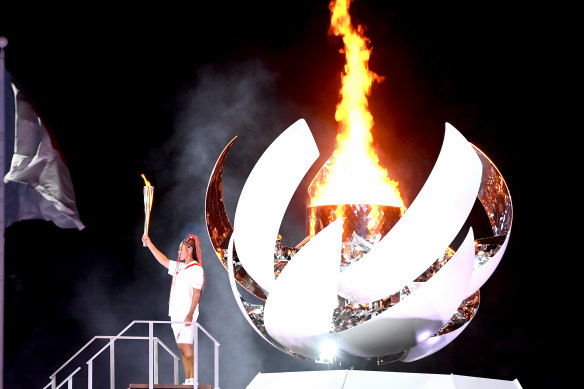
Tennis player Naomi Osaka lights the Olympic cauldron to kick off the Tokyo Games.Credit: Getty
Often, the loud cheers from outside the stadium, whether from supporters or protesters, were louder than any noises from inside the cavernous bowl. A spectacular moment came when 1824 drones hovered above the stadium forming a single globe - it was impressive as a technical feat, even more so as a unifying message.
When the Australians walked into the stadium, they beamed. No matter how much you wished it wasn’t true for them, or for all the other athletes, it was hard to escape the empty seats behind them. Broadcasters would struggle to make up for the missing 65,000 fans who would have lit up the stands.
On Thursday the city recorded the highest number of COVID-19 cases in more than half a year. A day later 5700 athletes marched into the national stadium.
Four-time Olympians and Australian flag bearers, Patty Mills and Cate Campbell, led 63 Australian athletes into the Olympic Stadium as the flame made its way to the cauldron.
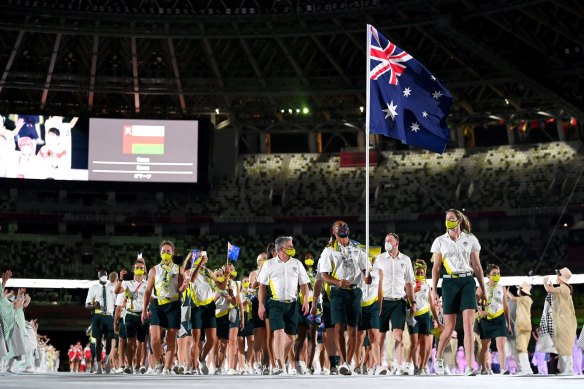
Flag bearers Cate Campbell and Patty Mills lead Team Australia out during the Opening Ceremony.Credit: Getty Images
Earlier in the day, the Japanese Defence Force’s aerobatics team traced five Olympic rings in the sky; below them, the bars were closed and the restaurants dry.
Nearby, a sober Japanese public growing increasingly restless about its state of emergency gathered to watch the torch pass through some of Tokyo’s streets. Two hundred protesters yelled: “Go to hell, IOC! Go to hell, Olympics!”
Others resisted quietly in their homes and through opinion polls, where up to 80 per cent of Japanese citizens continued to oppose the Games.
Those figures, so stark and so overwhelming, can only conjure thoughts of what could have been. This metropolis of 14 million, of izakaya bars and heaving streets, has never been so sleepy.
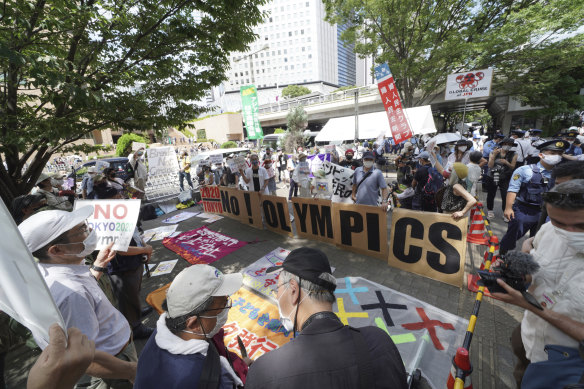
Anti-Olympics protesters hold signs during a rally near the Tokyo Metropolitan Government complex where the final Olympic torch relay event took place in Tokyo on Friday.Credit: AP
Outside the stadium, Japanese families, students and children were separated from the party their country was hosting by a four-metre barricade.
Yuka Yamada, a university student, said the barrier would keep Japan safe. “But it feels so sad,” the 22-year-old said. “There is no Olympic mood”.
Tokyo 2020 president Seiko Hashimoto, a seven-time Olympian, said that despite the circumstances, the athletes would treasure these moments forever.
“Step onto this stage with confidence,” she said. “I believe your strength will bring hope to people.”
IOC president Thomas Bach thanked the Japanese people for hosting the Games.
“It was a difficult journey with unprecedented challenges – first the reconstruction after the Great East earthquake [of 2011], then the pandemic. This is why our admiration for you is even greater,” he said.
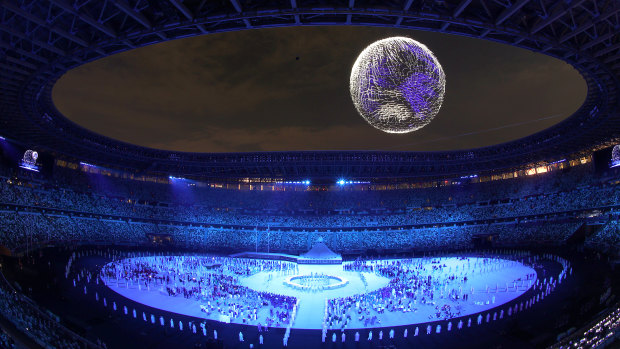
A drone display of the Tokyo Games emblem is seen over the top of the stadium during the opening ceremony.Credit: AP
Earlier Mansai Nomura, an adviser to the opening ceremony, said the Tokyo Olympics were taking place in an unprecedented time.
“People everywhere have been denied interaction with others and we now find ourselves in a situation few could have imagined,” he said.
“Given the severity of the COVID-19 pandemic we have designed the ceremony around the concept that the Tokyo 2020 Games can bring fresh hope and encouragement to people around the world […] through the power of sport.
Despite Nomura’s optimism, the opening gala for an event pitched to the world as a recovery from the tsunami that rocked the country in 2011, showed how far Japan and the world still has to go.
Absent was its core architect, former Japanese prime minister Shinzo Abe, who decided not to attend because of Tokyo’s COVID state of emergency. Present, to officially open the Games, a reluctant Emperor Naruhito, who a few days ago expressed doubts the Games should be held at all.
On Friday, the Asahi newspaper cited “confusion, distrust and unease” in an editorial to say “‘the festival of peace’ is now starting in an unimaginably disastrous state”.
Halfway through the athletes’ parade, the line outside the stadium had snaked for blocks. On one side the protesters called for the Games to be stopped. On the other, hundreds camped out hoping to catch a glimpse of a firework or a mascot.
Between them hung a single sign from an apartment: “Welcome to Tokyo 2020”.
This is a city divided. The Olympic Games have three weeks to try to unite it.
Never miss a medal or great sporting moment with our Olympic update emailed daily. Sign up for our Sport newsletter here.